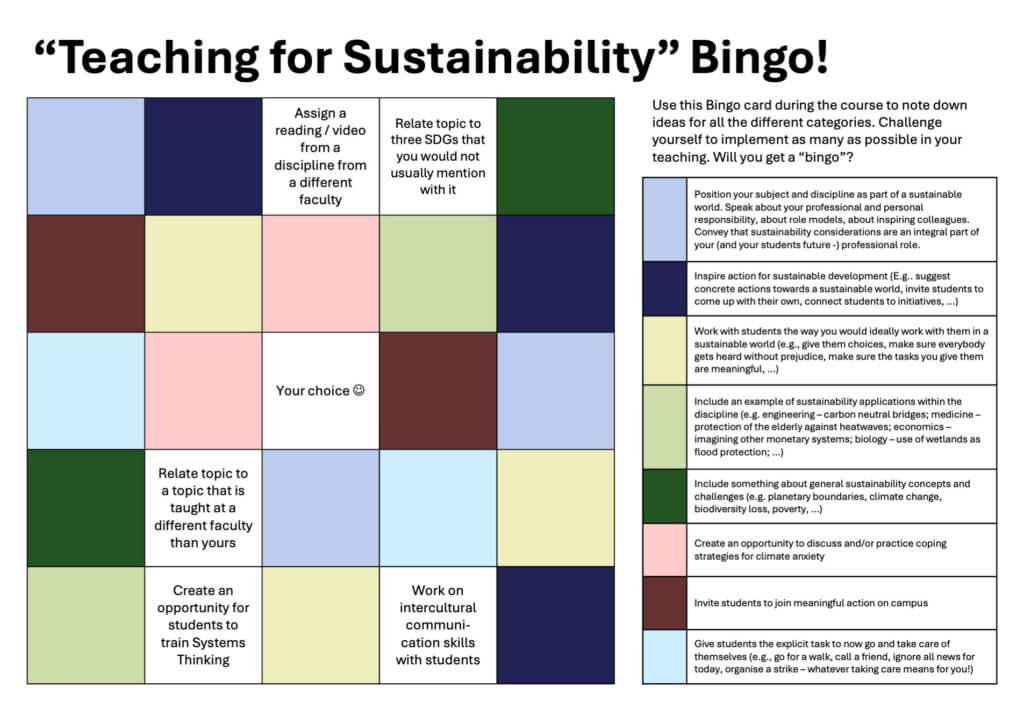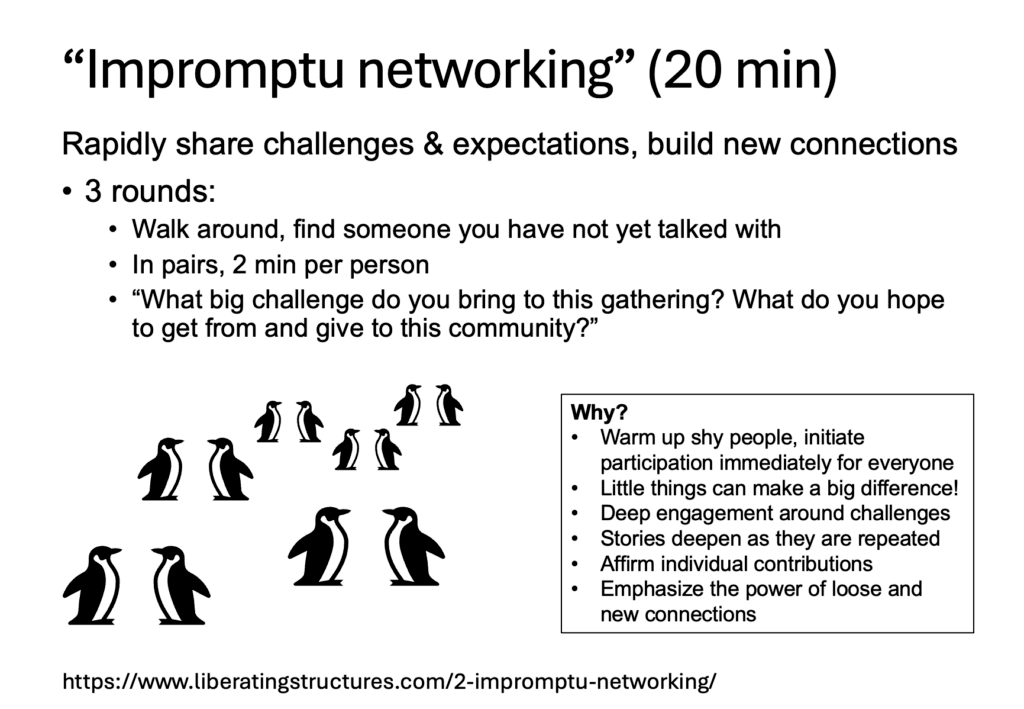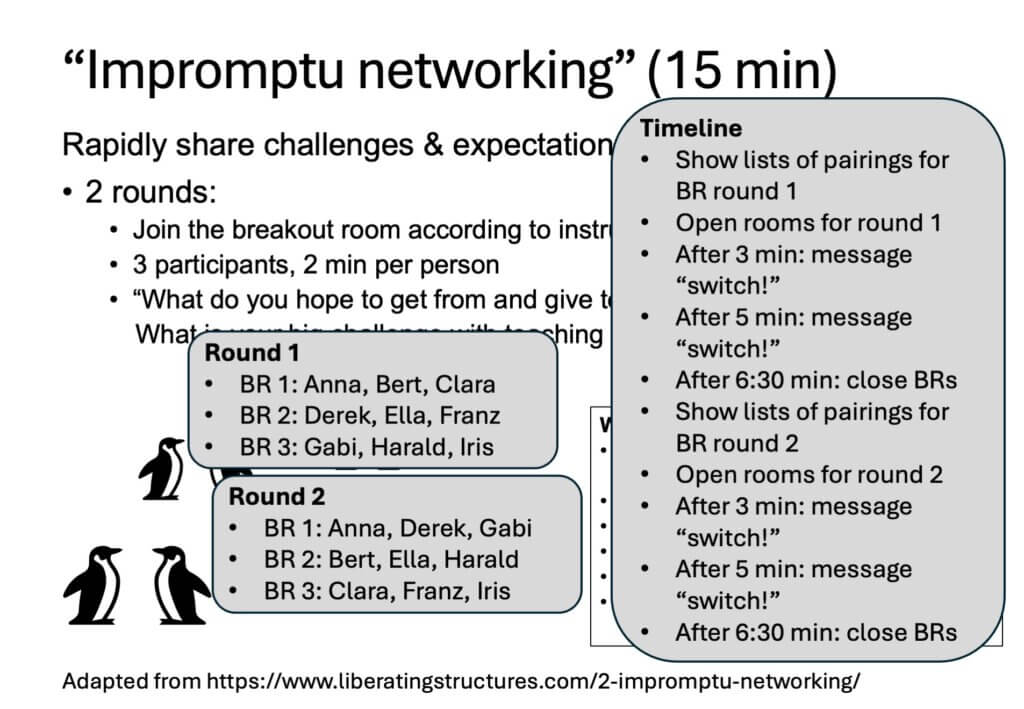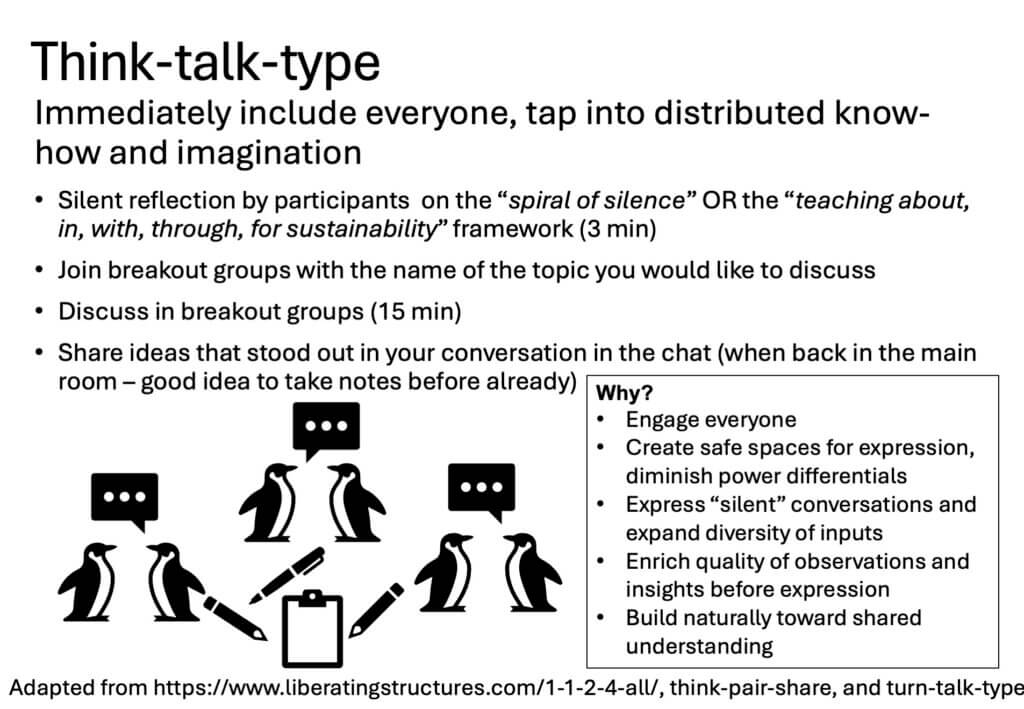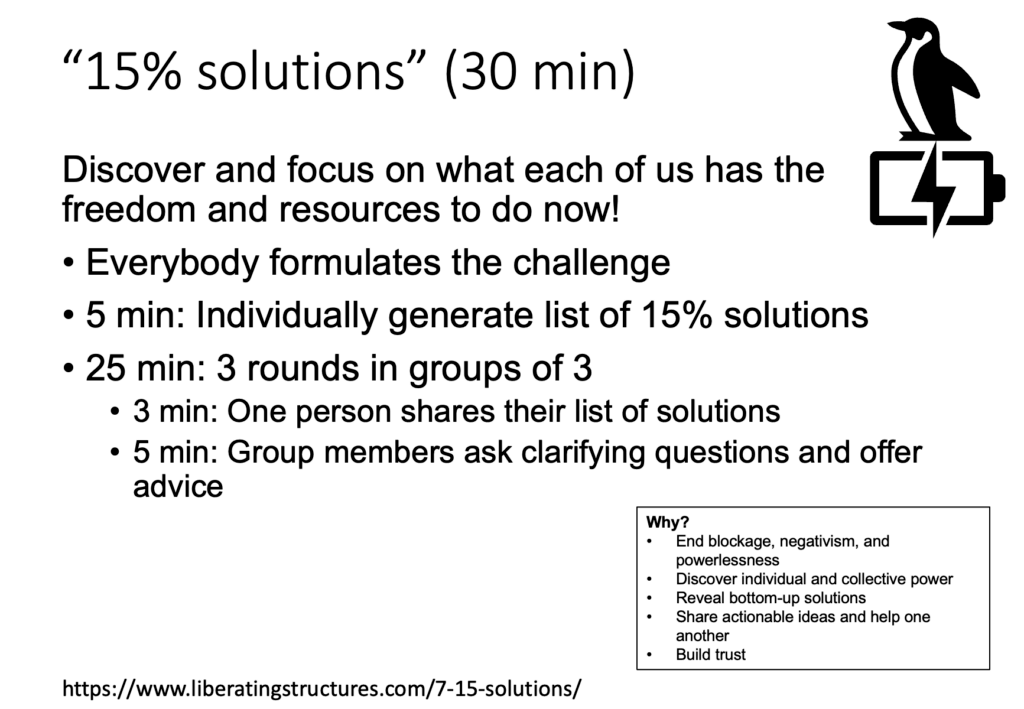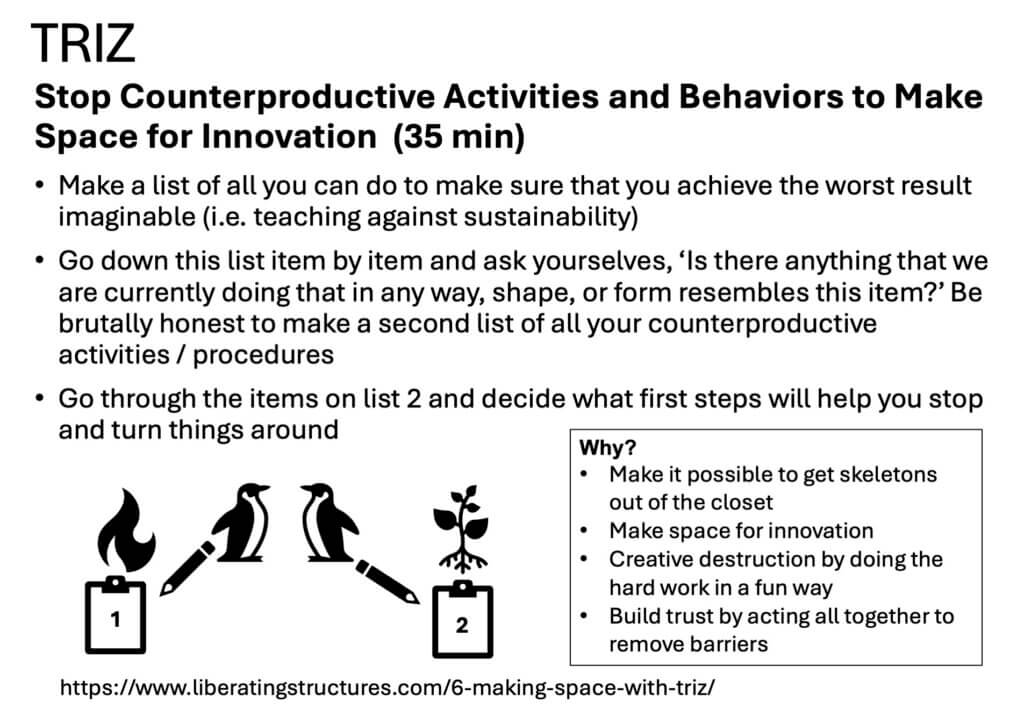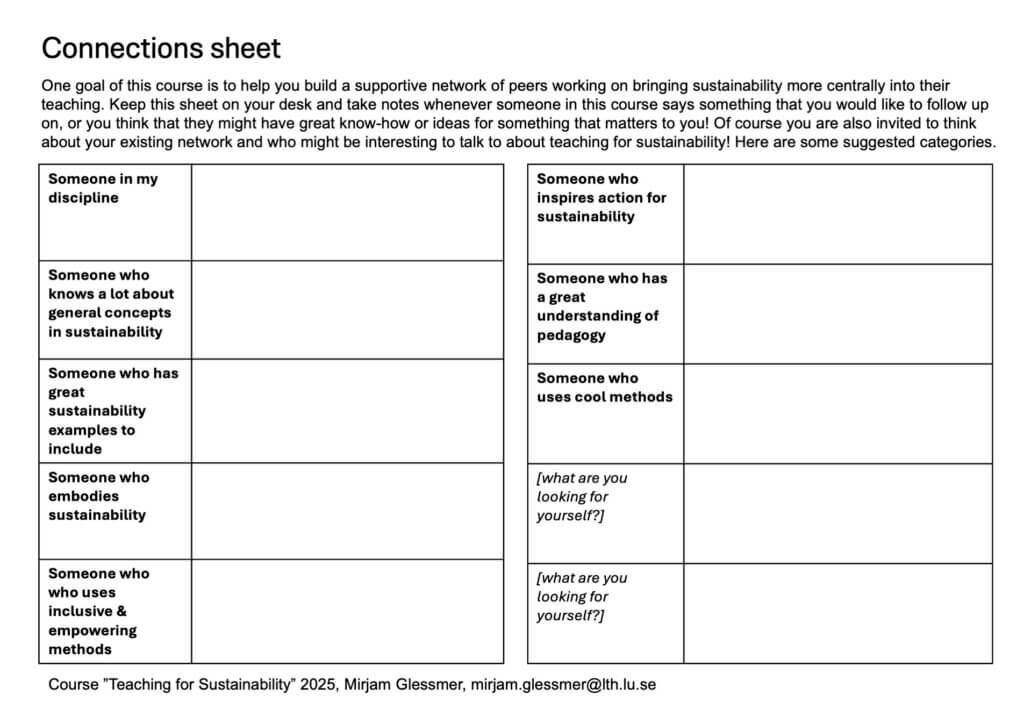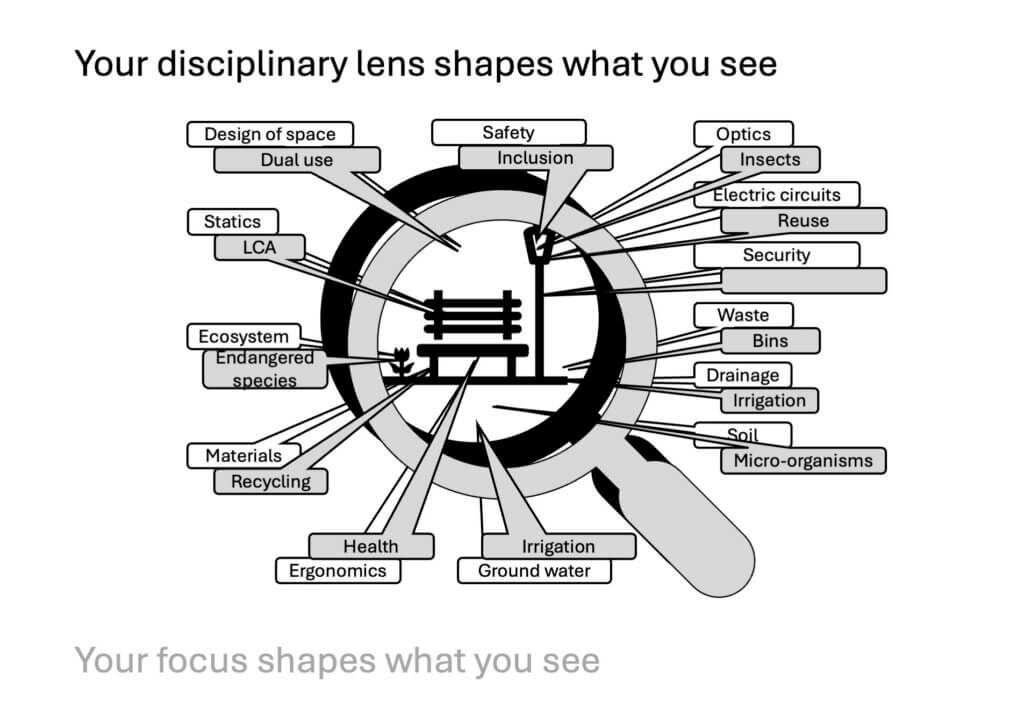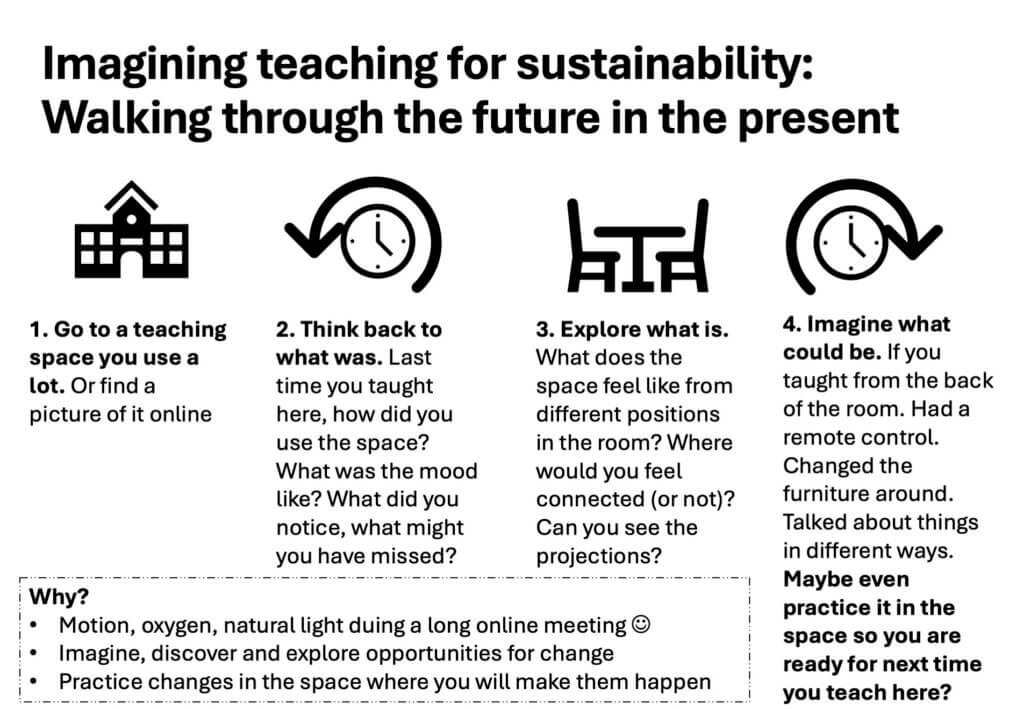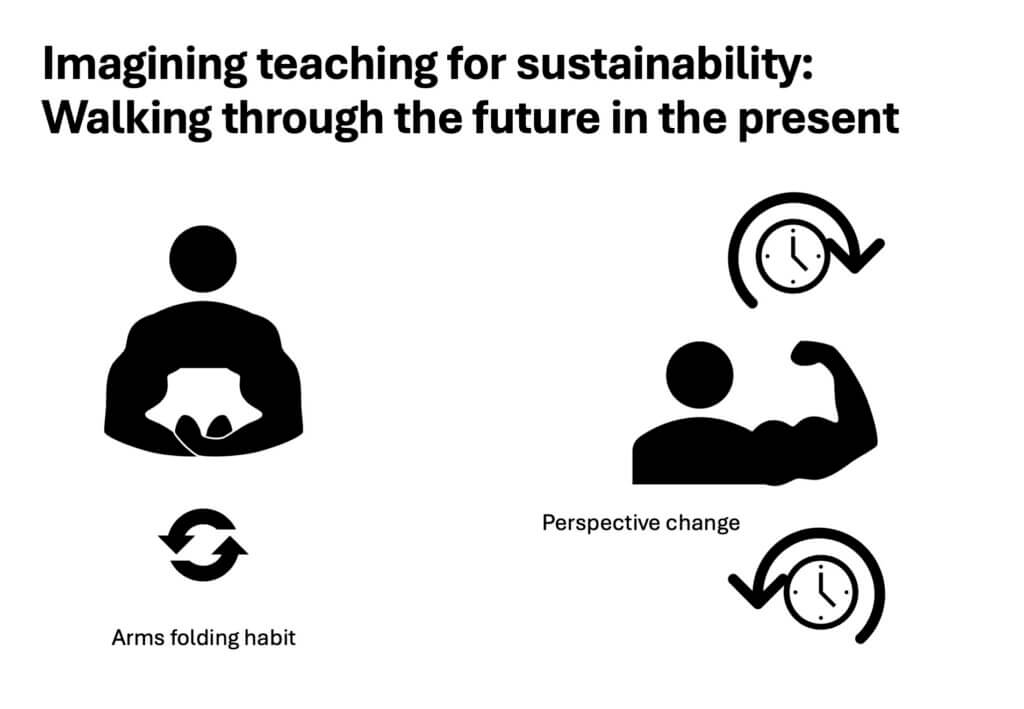
Preparing my course “Teaching for Sustainability” with the support of Noah (2025)’s brilliant book
In preparation for this fall’s online course on “Teaching for Sustainability“, I was looking into what kind of methods I want to model. And then — perfect timing — I started reading of Noah (2025)’s brilliant book on “Designing and Facilitating Workshops with Intentionality: A Guide to Crafting Engaging Professional Learning Experiences in Higher Education” (which I wrote about before more generally, and then picking up the idea of a teaching consultation menu and improving on it). And below I give you my main take-aways together with my thoughts on how they apply to — and influenced! — what we are planning to do in the course.
So let’s go through the book (well, my notes only, I left it at home in Sweden because I didn’t want to carry it to Germany, where I am writing from now…) and think about what I can learn for the course I am currently developing!
Planning the workshop
There are lots of useful tips for what to do before the actual workshop, starting out with becoming clear about what a specific workshop can and cannot do, and how it is supposed to contribute to the bigger picture.
The vision
I really like that Noah (2025) recommends starting from a vision. She distinguishes between a “lowercase p purpose“, the goals and objectives of a specific workshop, and the “capital P Purpose“, which is how the workshop contributes to a bigger vision. I have a hard time articulated my bigger vision — it is something about showing students that they matter, that they have both agency and responsibility to co-create their learning, and that we are together working towards the world we want to live in. But even though I haven’t clearly formulated my vision, I can see how my courses are all contributing with a “capital P Purpose” (for example, as you will see below, I use a lot of methods that “unleash and empower” everybody; or as I described above, I want to use my course on Teaching for Sustainability to also model inclusive and engaging online teaching). And in a way that makes it a lot easier to then describe the “lowercase p purpose” for a specific course, because the pressure to describe all the capital P Purpose stuff (without it overpowering the goals and objectives for a specific workshop) is gone.
To describe those, Noah (2025) pitches the one sentence presentation plan*, which you come up with by answering the questions “What’s the goal of the workshop? How will the attendees reach that goal? Why is this workshop beneficial to them?“. This is supposed to help determining what goes in and what goes out, so let’s give it a shot!
For my Teaching for Sustainability course, I would then say something like this: “With the “Teaching for Sustainability” course I hope to support teachers to enhance their teaching for sustainability by collaborating on a group project supported by seminars and literature studies, offering both theoretical grounding and practical, peer-informed strategies—beneficial for developing impactful, context-specific teaching practices as well as a supportive network of peers“. Not too bad! Maybe slightly too long, but a good start! And it is also helpful in that while I still want to model engaging online teaching, it is now much more clear that I don’t need to spend time on that explicitly. Although of course this then needs to be balanced with the advice to “nam[e] what you are doing and why” to make transfer easier for participants, so they can use the methods in their own teaching…
The logistics
Noah (2025) has lots of great practical tips for planning and preparing for a workshop:
- To plan the workshop dates, check multi-faith calendars, especially for work-restricted holidays, e.g. Rosh Hashanah and Eid. I had an experience recently where I was about to tell people to go help themselves to the catered coffee and cake, when I noticed a headscarf and remembered that it is Ramadan. I checked in with the participant and she told me that she doesn’t mind everybody eating and that she wasn’t fasting herself at the moment, but I would really have preferred having thought about the implications of offering food during a fasting time before the food arrived at the location.
- As soon as you decide you want to offer a workshop, make sure to block time to plan, create materials, rehearse, for preparation on the day of (set up the room and/or online environment), for follow-up right after, and for follow-up when participants have submitted their assignments and you need to write feedback. Possibly also for a follow-up chat some time after as a kind of reunion, where participants come together again, report on what has happened since, and can discuss questions that have since come up.
- Be really intentional with the name of the workshop! It “signals what the purpose of the event is, and also prepares people for their role and level of expected participation“. If it is called a presentation, people will not expect to be put in breakout rooms and participate actively, but they might join the call from public transport or their beds expecting that they can just passively consume… And if a name promises solutions but the workshop only provides reflection questions, participants might feel cheated. So it is actually pretty important to get that right! In my case, “Teaching for Sustainability” is really suboptimal in that respect (but since it is a course plan that has gone through several committees to be approved, there is nothing I can do a this stage other than starting to think about what I would like to call it next year).
- Also be intentional about doing things online vs in person: On-site / in person makes it easier to “read the room”, to get vibes from participants, to connect (but I think this is often used as an excuse by teachers — most people aren’t as good at reading a room as they like to think about themselves, and also connections don’t happen just because people are in the same physical space…). A disadvantage of on-site meetings is accessibility and the tendency to reproduce inequality* in access for potential participants whose time or mobility is more limited. Online meetings, on the other hand, are easier to access (both in terms of cost, but also in terms of automatic captioning and translations of video streams etc), easier to record, and there are many ways of interaction already built into tools. There is also a reduced environmental impact in comparison to on-site meetings that involve travel, and it is easier to collaborate across institutions when distance isn’t an issue. But: Zoom fatigue is real, and online meetings need deliberate attention on community building and for the presenter to make sure they don’t loose touch with the audience (as do in-person meetings, as I argue above).
- Also really helpful reminder: synchronous workshop time should make use of the different expertises, perspectives, … Noah (2025) writes that “[o]ne of the benefits of workshops is the incredible opportunity they provide to gather with people from diverse backgrounds and experiences to explore topics and discuss ideas together.” I’m taking that to heart and looking through if there is more we can flip in our plan to move things into asynchronous (self- or group-)study, to make time for interaction during the synchronous phases of the course.
- Also always important to provide choice! Part of what supports intrinsic motivation is autonomy, so giving choice is super important! Inviting people to do activities but to modify them to what works for them — for example going for a stroll and chat, or stroll alone, and choose between indoors or outdoors. Noah (2025) suggests to “include opportunities for participants to help shape what occurs during the session“, so now we have a discussion session where participants can choose a breakout room depending on which topic they would like to discuss, whereas before I had prescribed the topic. Another way to provide choice could also be a Tic-Tac-Toe (or a Bingo — read here for my instructions on how to create an activity bingo for teaching purposes! First draft of a “Teaching for Sustainability” Bingo below… Reading this book is great, but it also creates A LOT of work :-D)
- Now when we have our plan ready, Noah (2025) recommends creating a graphic organiser so people get an idea of what is happening when. Which I agree is always a good idea, and especially in this course where we bring two universities together and then have participants that take the course for 30 hours credit, while mine take it for 80 hours. So now I have at least a draft of one ready, to be discussed with my co-teacher next time we talk.
- Think through the technical setup of actually running an online workshop! Noah (2025) shares a picture of her workspace with two computers (one logged into the online meeting as host, sharing a video of her and slides; and one logged in as co-host, with document with all the links, information, instructions ready to copy & paste into chat), an ipad with notes, a phone with the time, a sticky note with the have-to-remember times (start, end, breaks), a water bottle, and an analogue notepad to take notes. One additional thing that I invested in during the pandemic and still like to have ready in case the natural light isn’t cooperating is a ring light to light my face for the video stream (here is the setup that I used during the pandemic from my flat in Kiel).
- Another really good advice is to “lead with your best stuff!“*. If you don’t start strong, participants are not going to stick around (or at least not pay attention) for you to bring the best that you saved for last…
- And one piece of advice that I need to put on my calendar as a reminder right before the next workshop so I definitely don’t forget: Have a list of “links to copy & paste into the chat” ready!!
The workshop invitation & accessibility
A workshop starts already with the invitation, long before people arrive at a venue or online call (and probably even before, with a good title and clear description of its goals!). Noah recommends to use the invitation for welcome and care, for example letting participants know that there will be breakout rooms where they might be asked to have their videos on, etc. Very important that there are NO SURPRISES!
It is always important to consider “Who is included? What is included? How is it included? From whose perspective? Using what sources?“*. I really liked the story told in the book about someone, when submitting a conference proposal for a presentation, being asked what barriers they anticipate participants might face, and how they are proactively working to minimize them. Everybody should be asked that all the time! (and then, of course, use the “reach everyone, teach everyone” plus-one approach to incrementally become more accessible.
Noah (2025) also shares the language she uses in her invitations where she asks participants “Please describe any accessibility needs or personal preferences that would support you in participating fully and comfortably in this event“*. I routinely have a very similar sentence in the welcome emails I send out to participants and that has led to people sitting in specific spots so they can more easily hear what is going on, or being assigned a different group than initially planned because they asked not to be grouped with a specific member. If the goal is learning, then we should do what we can to remove obstacles!
I often also use the welcome email to get participants to start thinking about the topic already, for example by recommending they watch a youtube video or read a specific piece. And I usually ask people introduce themselves in discussion thread on the learning management system, but I should really consider Noah (2025)’s suggestion of video or audio recordings of how names are pronounced!
During the workshop
Unofficial start
As Noah (2025) also recommends, I really like starting before the official start. In-person it is easy to ask people to build name tents already, or have a slide(show) up with either fun facts, reflection questions, or even tasks to start thinking about. Online things work similarly, but responding in the chat to something shown on a slide might be a bit problematic depending on the video conferencing software; in zoom, for example, people who join cannot see the chat history, so everything posted before other people join is lost to them.
Pet-peeve alert! I would like to offer a different perspective on the common advice to play background music during the “unofficial start” of an online workshop to make things less awkward than people sitting at their computers in silence. I really hate having someone else’s music play in my own space without my consent, and I also feel that I do have to listen to it so that I don’t miss out when the slightly more official start of the unofficial start of the workshop begins. I feel that if I am in the meeting and people can see me there, there is the expectation that they can start talking to me at any time or at least assume that I am aware of anything being said then, so I cannot turn down the sound until it is time for the official part to start and just join then, because then I would not be able to respond to anything happening during the unofficial start. But at the same time, it is exhausting for me to listen to music, and when I know that I have a long online-day ahead of me, it feels like someone is wasting my energy before the meeting has even started. I have seen this advice before in several places but I do not understand why it is such popular advice.
Introduction
In my courses (at least when they are at least a week worth of work) I like doing introductions in a discussion on the learning management system before the first course meeting. That way, participants have to log in and start thinking about the course already, and with the information they give me (teaching experience, subjects they teach, often country of origin, …, expectations that they have of the course) I can easily assign diverse groups, or group people by whatever variable I would like to group them. Also they can look at each others’ introductions, see if they know someone, potentially confidentially let me know that they cannot work with someone and ask to not be put in the same group as them (as I wrote above, that has happened before and should of course be respected), or even reach out to someone based on their introduction. I always introduce myself in the same discussion thread, too, and know that participants often follow a link to this blog and check me out.
During the meeting, introductions can then be a lot more targeted on what is relevant to the specific course (see for example the “impromptu networking” method below).
Another introduction activity that I really like is asking people for their nerd/geek topic — what do you love talking about? This is great for people to discover connections to others and knowing what topic they can use that the other person is going to definitely react positively to when they approach them to start a conversation!
It is important to remember here that while we as facilitators often want to introduce ourselves with a lot of detail to build connection and make ourselves approachable, we also build a hierarchy if we take up a lot more time for ourselves than we give to the participants! The signal is very clear then about who is more important than everybody else…
Roadmap
Also important at the start of the workshop is to share an outline of the agenda and the goals, to set expectations and give orientation (also nice to refer back to later to show progress, how things connect to each other, …). OR to do the Goal Ranking and Matching method I rediscovered yesterday to make sure that there is actually a match in goals, so that participants can relax and engage rather than having to worry whether the topics that matter to them will actually be mentioned.
During such a “roadmap” talk, we can also share preferences, for example that the cameras are mostly on, but that it’s ok to have them off when participants feel they need that for a while.
Group agreements
This is obviously important, especially for groups that work together for a long time, but also in general to just set ground rules. Noah (2025) recommends the paper “Leaning in: A student’s guide to engaging constructively with social justice content” by DiAngelo & Sensoy (2014) to start conversations about difficult topics. I loved reading it, but I am wondering how to make it work in my context here in Sweden. I think we might have to rewrite quite a bit!
Start of day 2+ — The rear-view mirror
One thing that we routinely do in our “Introduction to Teaching and Learning” course (which is a 3-week course, whereof 5 days are done in-person, often all in one week) is a “rear-view mirror” exercise. This is about looking back on what happened on previous days, activating knowledge, picking up on any thoughts or questions that have come up since, so we can then continue building on that. The rear-view mirror can take different shapes, but is usually done in small groups. For example, sometimes we ask participants to individually list the three most interesting concepts from the previous day, then create a list of the five most interesting concepts on their table of 5, then discuss those, and finally every table can report back to the whole group if they find something interesting enough to do so. Of course there are many other ways to do it, but it is always good to have a rear-view mirror activity planned for a smooth and seamless start into later days of a workshop.
Learning sequence
I really liked the suggested “anchor – add – apply – away” learning sequence! It is similar to Kolb’s reflect-theory-plan-experience, but sounds so much nicer! This is going directly into the planning for my MOOC! :-D
Handouts
I really like the 1-page overviews that Squiggly Careers do for all their podcast episodes, so Noah (2025)’s reminder to consider handouts really resonated with me! During the pandemic, I worked with a lot of teachers who sent out care packets to students, but it never occurred to me to send out documents that participants can choose to print and then scribble on during an online workshop. But now I have prepared some (that will also be provided electronically for people who prefer that) and I think it’ll actually be really nice and helpful to switch formats even just that little bit to encourage taking notes by hand, in a structured handout sheet!
Great facilitation methods
Many awesome facilitation methods are collected in the Liberating Structures. Did you know that there is now a Liberating Structures app? Really useful to find the right method for your purpose!
Anyway, here are some highlights and considerations for how I would modify them so they work online. Have to demonstrate to people how to teach through sustainability!
Impromptu Networking: Rapidly build connections and shared purpose!
I think this is a brilliant method (originally a Liberating Structure) to support quick formation of relationships and deep conversations that I have used in many courses before (for example here). In a room, these are my instructions:
Online, it obviously doesn’t work as easily to “walk around and find someone you haven’t talked with before”, so some options are to
- randomly assign three rounds of pairings in breakout rooms (and hope that they are different each round)
- prepare pairings and
- upload the lists on zoom to assign pairs to breakout rooms (but I need to figure out how that works!)
- share the lists and numbers of breakout rooms for each round on a slide or in a shared document, and people need to join the correct one (might take a little while, but might be my preferred option — see slide below; the grey fields would be animated and come in to show the pairings in the breakout rooms, and the timeline of what to do, which I need to not go crazy!)
- let people find new pairs on their own, by opening up the correct number of breakout rooms, letting people hop in and out until they find a room with someone they haven’t talked with (CHAOS! But I think instead of still creating connections and interactions like it is doing this in person, I feel like online this might just be annoying and stressful)
For me, the most important reason to use this method is actually to let people think about what they want to get out of a workshop, and how they can contribute. It’s a nice benefit that they also connect to others in a deeper way than “just” talking about what institute they are from and what subject they teach!
1-2-4 ALL, to include everyone and tap into distributed know-how and imagination
I haven’t written about the “1-2-4-ALL” Liberating Structure before, because it is basically an extended “think-pair-share”, which I use all the time. If we drop the “4”, it is super easy to do online: Everybody thinks on their own for a bit, then people are sent into breakout rooms in pairs, and then everybody is called back. Another alternative, suggested here, is to send people into threes instead of pairs. But for doing the real “1-2-4 ALL”, I probably need to either figure out how to upload lists with pre-defined breakout rooms to zoom, or move people manually from one room to the next (which is actually also not super difficult these days…)..
Noah (2025) suggests a variation of this: turn-talk-type, so think for yourself, turn to someone (or be assigned in a breakout room with them), talk, and then type in chat (instead of big discussion with everybody).
So merging these suggestions, this is what I want to do in my upcoming course (see slide below): This activity happens after I have given input on two (related) topics. Participants reflect for themselves on one of the topics, then pick breakout rooms that are named those two topics according to their interest (this is also nice because it gives them choice!), discuss there for 15 minutes, then come back into the main room and share their most interesting ideas in the chat. We then probably pick up on those with the whole group.
15% solutions, to discover and focus on what each of us has the freedom and power to do now!
Luckily, the “15% solutions” Liberating Structure is super easy offline and online, since it only requires breakout groups with 3 people each, and possibly a broadcasted message every 8 or so minutes to move to the next participant’s topic.
TRIZ, to stop counterproductive activities and behaviours to make space for innovation
In the original “TRIZ” Liberating Structure (so called after a russian engineering structure), to “clear space for innovation by helping a group let go of what it knows (but rarely admits) limits its success and by inviting creative destruction“, participants 1) make a list of all the things that could hinder progress, 2) go through that list and make a second list with all the things that apply in their specific case, and 3) think about steps to prevent the things on the second list. As I have described here, I really like this structure when writing group contracts, but I think it also works beautifully in the context of Teaching for Sustainability, here with a focus on what would be teaching against sustainability, and then looking at what we are actually doing and how we can stop doing it and start teaching for sustainability.
Social annotation activity
This is an activity suggested by Noah (2025): take a bad syllabus and let participants add comments in a shared google doc (or modify with tracked changes). I like working with shared documents (although I prefer shared slides, where everybody can put their little text box wherever they like and one person writing doesn’t push someone else’s text off the page…) and I think that this is a really good way to engage everyone (in contrast to one person editing a document and sharing their screen). Even in person when people are sitting around a table, it is nice if they can all work in the same shared document!
Four corners
This is based on an in-person activity and the four corners of a room, but online you can use “sticky notes” or the text box features to place yourself in space to show interest in topics, agreement with certain positions, etc. A bit like sociometry? I like these types of activities, and it might be interesting to try Pihkala’s exercise of walking on a large model of the eco anxiety process as embodied activity, only online? I have to think about how to do that!
Anticipation guides
Here I should definitively have taken better notes! What I wrote is “Statement, before, after, notes”, and what I think it means is to either provide participants with a statement about the course, or let them come up with it, in the “before” write about their anticipations about what is going to happen relating that statement (or maybe if they agree or disagree, or how they interpret it), and then let them also write about it after the fact so they can compare the two. “Notes” probably means just that.
“Thunderstorm in the chat”, to collect lots of ideas at once
Love this method (ask people to pre-write a response to a question, and then on a signal post it all at once in the chat) and I actually use it a lot! Great so people don’t self-censor themselves too much based on what other people wrote before them (since they all post at the same time).
Quick voting on questions that come up spontaneously
If you had the chance to plan audience response questions using tools like Menti — great! If you have not (and don’t have ABCD cards available), there are other, similar methods, for example voting by showing one to five fingers, or by covering different corners of the video with a finger (or percentage of the visible field). This works great to check in on participants’ energy levels, but also on which of several options participants want to discuss next.
Gallery walks
For example in google slides, after participants have worked on slides individually or in small groups: Everybody flips through the shared document together, and each slide is presented by their creators. Works great (and if you see that people are moving on to other slides it’s a sign that maybe you need to move on…)!
Snowball toss
One last method, even though I have no idea how to do it online: The snowball toss! People write something on paper (probably prompted to something specific), crumble up the paper, throw it across the room, then go find and pick one up, and lastly read it out loud. Nice method to mix things up, create energy in the room, and read out things without it being obvious who the author is. Wish there was a good way to do this online that was equally as energising!
Other useful stuff while running a workshop
Pairing up, or grouping people
How to do that? Many options!
- Randomly: Use a deck of playing cards to sort people into pairs (same suit on their card, e.g. hearts)
- Find discussion partners based on what you would like to discuss with them, collected on a “dance card”: Bunch of topics and add the discussion partner’s name! That is great to make sure that you find someone close to your own subject for when you want to discuss content, and someone else when it is about other stuff (see my example below)
- Name breakout rooms with different discussion topics (or show numbered list on slide) and let people join that number room
- Video, audio, chat, silent breakout rooms!
Assigning a designated speaker
This is generally a good practice so it’s not always the same people talking…
- “Who got up the earliest?”, “who ate the most red food for breakfast?” In contrast to asking for the person in the read sweater to speak (really hard to get out of if you really don’t want to speak for whatever reasons) or the person who went on the vacation trip furthest away last summer (used to be great to map out economic situations, now also brings in discussions about climate and responsible behaviour), this question works well to nudge people without forcing them
- Person to the left to the one who spoke last, or assigning numbers to seats and circling through (but that sounds almost as bad as having to read something in language classes as a kid, when you would count how many people are still left before it’s your turn and then which paragraph you are most likely to end up with…)
Parking lot for questions
This is always very useful: In an in-person setting this can be a whiteboard or flipchart in a corner where people can add things they want to remember to bring up later, virtually this can be a slide in a shared slide deck, or a discussion on the learning management system. Online has the advantage that we can respond online, too, for example with links or similar, but on the other hand that’s also the danger — that we don’t get to it with enough time because we can always write something about it later…
When people really need a break…
Of course, the best option would be to give them a break, ideally even before they realise they need it, and invite them to go for a stroll outside. But the next best option, after at least a mini break, is to do small “wake up” exercises like these that I learnt from Kjersti during the pandemic and have used a lot on- and offline since!
Reflection
Even though we have reached the stage of blogpost writing where this will be really short, I want to mention a couple of the reflection methods that Noah (2025) suggests:
- “3-2-1”: 3 things I leaned, 2 ways I can use it, 1 feature I want to explore further. I like a good structure!
- Also always really nice: suggest a hashtag and encourage participants to share on social media!
- Continue-start-stop on the workshop topic: Based on what I leaned today, what will I continue, start, stop doing?
- “WOOP: Wish, outcome, obstacle, plan”
- Of course also minute papers, “quick writes”, etc
Recognition
I really like the reminder to thank participants for their time and contributions. Noah (2025) writes “I know that by choosing to say yes to this workshop, learners had to say no to something else“, and that is a really good way to put it, and also a really good reminder to make the workshop worth their while and not waste their time…
Feedback
Towards the end of the workshop, it might be nice to ask participants for feedback. Ideally in a way that feels meaningful to them, too (so they get, for example, the chance to reflect on something meaningful), rather than just providing data to the facilitator… Noah (2025) suggests several methods, e.g.
- Responding to “I like, I wish, I wonder”
- Responding to the “Critical Incident Questionnaire” about when participants felt most engaged, puzzled, confused
I feel like at this stage of writing I am getting really sick of this blog post, it is waaaaay too long already. But it is definitely good to look through my workshop plan with the lens of the advice given in the book!
After the workshop
I live that this part is included! The workshop itself might be over, but it can still continue having an effect on participants!
Get more feedback & document
In the book, the suggestion is a “share your story survey” (and since reading the book, I have discovered Wenger et al. (2011)’s value creation framework with reflection prompts, or what I would be really curious to try, the one word summaries to get more than just “facts”!). But in any case, it is a great suggestion to collect feedback not just for future improvements, but also to document learning for yourself and the participants, and to possibly share it with potential future participants.
Sharing resources
The suggestions here are collaborative online boards with “key takeaways”, “questions”, “challenges faced”, “success stories” that participants can continue to add to after the workshop is finished. I think it is a lovely idea, but will people do it? I have tried continuing to add things to collaborative slide decks that people worked on during my workshops, but I don’t think that people typically go back and check. Not that they don’t intend to, but everybody is busy… I think for this to work, there would have to be a lot of effort into ongoing communication with participants to let them know when there is something new and support them interacting with each other.
(Virtual) meetup
…to keep the conversations going, catch up, share new inspiration. Loved the suggestion, suggested it to my co-teacher for our course, and we are now planning to do it!
But now on to something from outside the book:
Activities on sustainability topics
Here are a bunch of things that I have planned specifically for my “teaching for sustainability” online course!
Connecting with the world: The Active Lunch Break
My active lunch break (with the “carving space” sustainability twist) is about going outside and reconnecting with the real world and discovering links between our subjects and sustainability “in the wild”. These can be brought back into the classroom (or the students outdoors) for more relevance and connection. Here are my slides with the instructions. First the general motivation:
And here is what they are actually going to do:
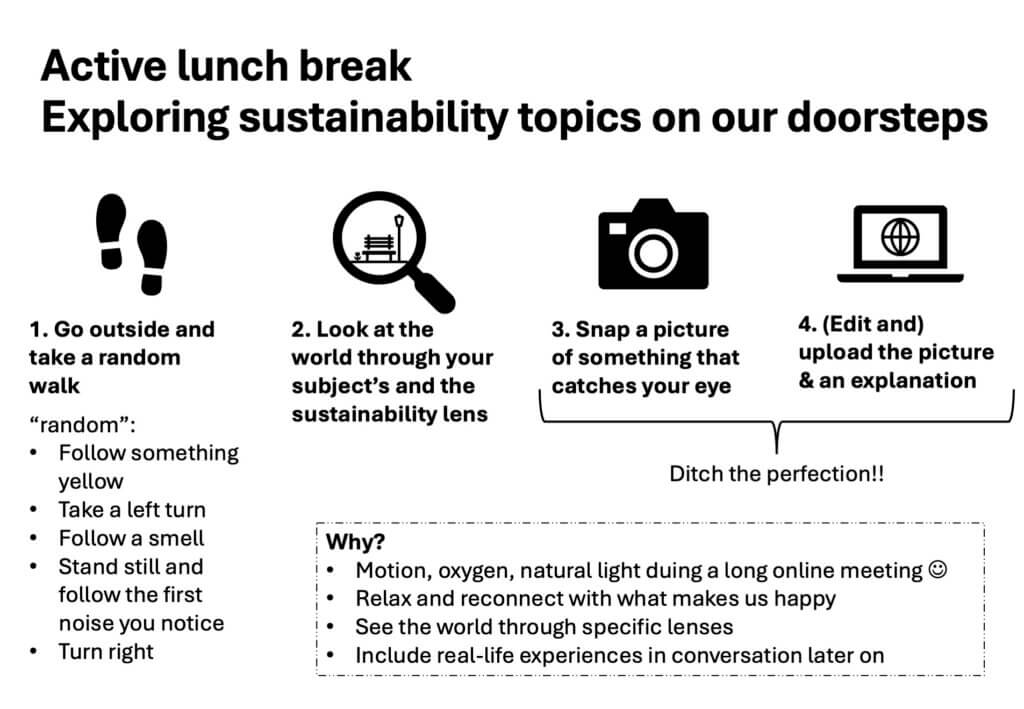 This activity, together with an article that I read, inspired another active lunch break activity:
This activity, together with an article that I read, inspired another active lunch break activity:
Imagining future teaching: Walking through the future in the present
This activity is about imagining, discovering, exploring opportunities for change in the space we want to make it happen — a dry run of saying something that might be slightly difficult, speaking from a different part of the room to mix things up, whatever it may be. Change is uncomfortable, so this is a low-threshold opportunity to practice it.
Small activities to explore systems thinking in online settings
I recently wrote about the Climate Change Playbook and the Systems Thinking Playbook, both of which are amazing collections of playful approaches to complex topics. But how to do that online? There are some that work well, for example the “arms crossed” and “circle in the air” games (both could work well in the lead-up to the “walking through the future in the present” activity to show how easily we fall into habits and how a different perspective can change everything! Look, I even made a slide to remind me to do that before I start on the other activity… Why do they only have such weird arms as icons?).
Several ones with folding and tearing paper could also work well, and the pen one, and “1-2-3-Go!”, i.e. actions speak louder than words, where participants are supposed to clap at “go”, but typically clap when the facilitator claps… And then the “mind grooving” where our brain leads us into traps because brains are laaaazy by default (at least I know mine is!).
But that is it for now! Phew!
* Added on 7/8/2025: After I had sent a link of this post to the author, she sent the kindest email back with a few notes (“to give credit where it’s due”):
- The one-sentence presentation plan and the advice to “lead with your best stuff” came from my interview with Norman Eng.
- The part about how on-site workshops can “reproduce inequality…” came from Maha Bali & Autumm Caines.
- The advice to consider questions like “Who is included?…” came from the book, Teaching for Diversity and Social Justice
- The language about accessibility needs came from the Virtual Gathering for Educational Developers
Noah, T. (2025). Designing and Facilitating Workshops with Intentionality: A Guide to Crafting Engaging Professional Learning Experiences in Higher Education. Taylor & Francis.
DiAngelo, R., & Sensoy, O. (2014). Leaning in: A student’s guide to engaging constructively with social justice content. Radical Pedagogy, 11(1), 1-15.
